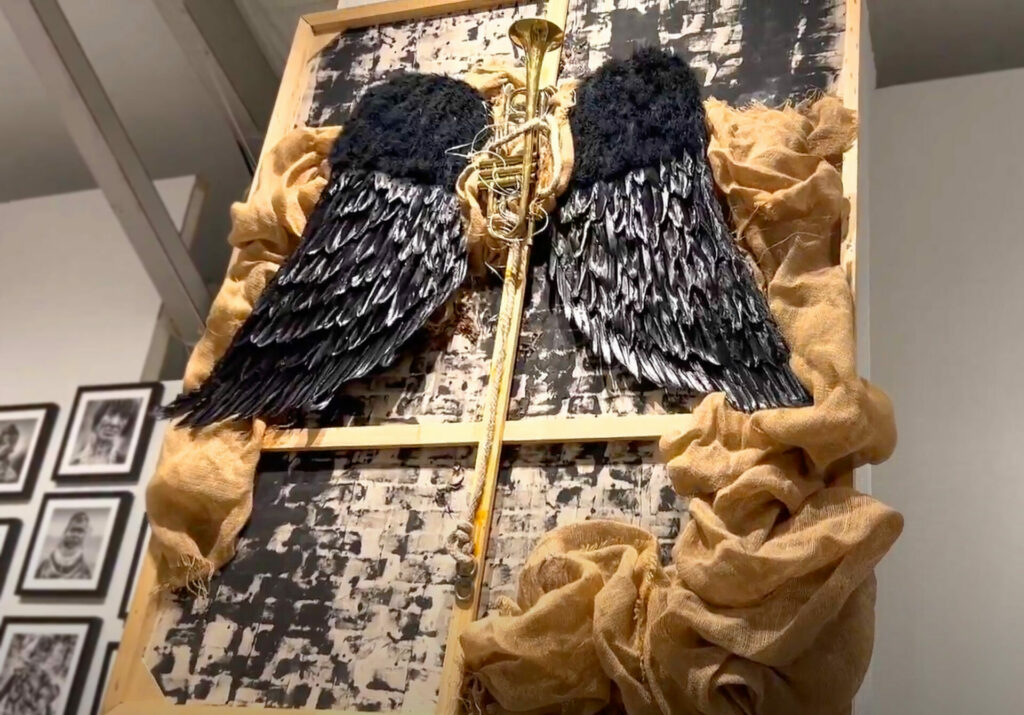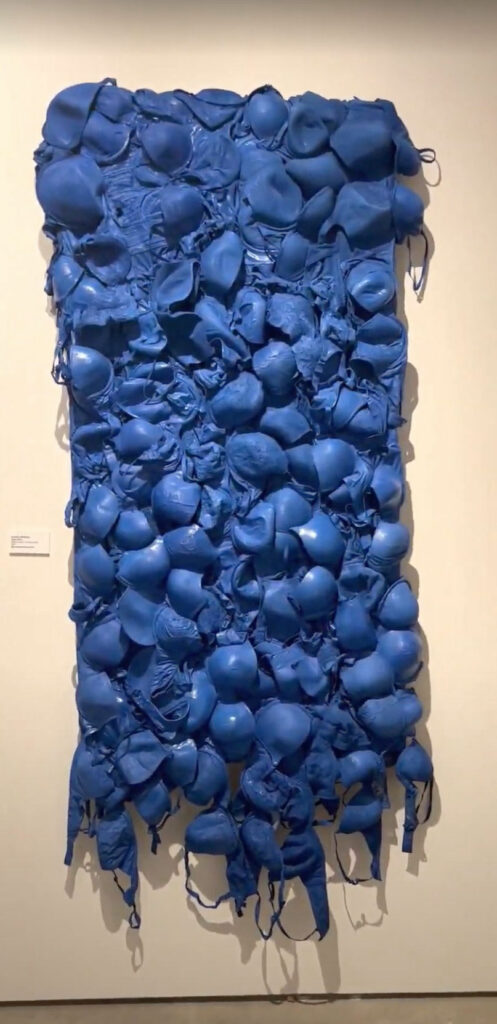Interview: Leonor Anthony
My name is Leonor Anthony. I was born in Cuba, and I left Cuba when I was five years old. So I’ve been a political refugee since then. The kind of art that I do is Activism Art. I refer to myself as an ‘Artivist,’ so I use art as a vehicle of Activism. That’s my voice.
Talk about your experience in your work as an artist and an activist, with this piece behind you.
Well, the work that I do is both. I am an activist all the time. So this piece behind me, I left it untitled because I want the work to relate to people and let them see what they see. But my concept was the fact that there are no black angels. No angels of color, like you and me. It’s always blonde angels or angels with translucent skin. That language has been there even from the times of the scriptures- what is good and not so good.

So I created my black angel. My black angels are Loui Armstrong, Luke Ellington. I wrote a book about jazz and the civil rights movement in my work called ‘Sounds of Freedom:’ this is part of that. And I reversed it: I brought what’s usually behind the canvas to the front. Because I want to change that conversation and let them look at us for who we are and our character, not the color of our skin.
So I created my angel, and it’s black. I love black!
So I created my angel, and it’s black. I love black!
How would you like your audience to see you as an artist?
I want the audience to see me as an activist first. Art is my voice, and I communicate, and hopefully teach or at least make somebody think, through the art.
So because I look the way I look, I am a very light-skinned Cuban with red hair; I can talk and speak for those who do not have a voice, who do not get heard because of how they look. So I don’t take that lightly; I can go anywhere and talk to people. And when they say ‘well, you’re not Cuban’: yes, I am. And my brothers are dark-skinned, so just because I came out a little light doesn’t mean I take it for granted; because I can speak.
And so, an activist first, an artist second.
So because I look the way I look, I am a very light-skinned Cuban with red hair; I can talk and speak for those who do not have a voice, who do not get heard because of how they look. So I don’t take that lightly; I can go anywhere and talk to people. And when they say ‘well, you’re not Cuban’: yes, I am. And my brothers are dark-skinned, so just because I came out a little light doesn’t mean I take it for granted; because I can speak.
And so, an activist first, an artist second.
What is it like as a political artist working with a gallery? How do you establish a relationship with your work and the gallery as an artist? Do you have any advice for up-and-coming artists?
For an up-and-coming artist, what I would say is always stay true to yourself. Do not make art to sell. Make art that is ‘you,’ that represents what you believe. Something that is your heart and your soul and is authentically you. When you do that, it will sell; because people love authenticity.
When you start making art thinking about if it will sell, that’s not good. Dig deep, go to the things that matter to you. Or go crazy, be free, without thinking about whether someone will spend money on it.
Look at Pascal; authentic. That was him, beginning to end. What he believed and his sensibilities, his freedom; he was free. When you become free, your work will soar. Your life will soar.
When you start making art thinking about if it will sell, that’s not good. Dig deep, go to the things that matter to you. Or go crazy, be free, without thinking about whether someone will spend money on it.
Look at Pascal; authentic. That was him, beginning to end. What he believed and his sensibilities, his freedom; he was free. When you become free, your work will soar. Your life will soar.

Talk about this piece. What does this piece mean to you?
This piece means a lot: modeled after a protest in Kerala, India, where women were not allowed to attend the temple. So they had a peaceful protest and did a human chain for, I believe it was 385 miles of women. And peaceful demonstrations are so powerful, so incredibly moving.
And I was watching this thinking: ‘wow, I’m so proud to be a woman right now.’ I thought: ‘look at all those bras, all those women.’ And then I said: ‘someone must’ve been working with bras,’ right? No one’s working with bras. I googled, I researched; no artist working with bras. So I thought: ‘that’s it, it’s mine.’
So I created this project, called ‘Sustaining Love,’ which is women supporting other women worldwide. So in this particular piece, I attained two goals. All of these bras were given to me by women who are survivors of breast cancer, every single one of them. Every last one of them is attached to another, so it’s this idea that we are here to support each other throughout the world.
The piece is named ‘Deep River.’ Because between the 1300s and the 1700s, probably a million women were murdered with the disguise that they were witches. But it was an assault on women, a war on women because they were deemed disposable. Those women, we will never know their names, but I wanted to remember them. After they were tortured, impaled, burned to death, whatever they did to them: they threw the remains in the rivers. So all those rivers in Europe were at some point filled with women. And I wanted to do an homage to them.
I did a piece in red, like this only in red. That piece went to the climate summit in Glasgow a month ago. So then this piece, after this, is going to Moscow. So my goal is to go around the world with the bras, and hopefully, end up in Central Park and do an entire chain of women in Central Park. And again, this is not political in any way, shape, or form. It is a call for unity and about the power of non-violent protests.
And I was watching this thinking: ‘wow, I’m so proud to be a woman right now.’ I thought: ‘look at all those bras, all those women.’ And then I said: ‘someone must’ve been working with bras,’ right? No one’s working with bras. I googled, I researched; no artist working with bras. So I thought: ‘that’s it, it’s mine.’
So I created this project, called ‘Sustaining Love,’ which is women supporting other women worldwide. So in this particular piece, I attained two goals. All of these bras were given to me by women who are survivors of breast cancer, every single one of them. Every last one of them is attached to another, so it’s this idea that we are here to support each other throughout the world.
The piece is named ‘Deep River.’ Because between the 1300s and the 1700s, probably a million women were murdered with the disguise that they were witches. But it was an assault on women, a war on women because they were deemed disposable. Those women, we will never know their names, but I wanted to remember them. After they were tortured, impaled, burned to death, whatever they did to them: they threw the remains in the rivers. So all those rivers in Europe were at some point filled with women. And I wanted to do an homage to them.
I did a piece in red, like this only in red. That piece went to the climate summit in Glasgow a month ago. So then this piece, after this, is going to Moscow. So my goal is to go around the world with the bras, and hopefully, end up in Central Park and do an entire chain of women in Central Park. And again, this is not political in any way, shape, or form. It is a call for unity and about the power of non-violent protests.


